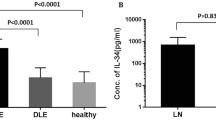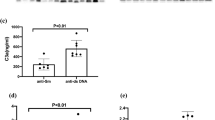Abstract
Our objective was to study a possible contribution of major histocompatibility complex (MHC) genes to soluble HLA-I synthesis in patients with systemic lupus erythematosus (SLE). Solid-phase enzyme-linked immunoassay (ELISA) was used to measure sHLA-I in the sera of 20 patients with SLE and 76 normal controls with known HLA phenotypes. Serial serum samples (n=108) from the above group of patients (n=19) were further investigated by sodium dodecyl sulfate polyacrylamide gel electrophoresis (SDS-PAGE) and immunoblotting. Soluble HLA-I levels were abnormally higher in patients with SLE than normal controls (P<0.0002). No complete HLA haplotype has been identified to be correlated with high or low sHLA-I secretion. Only the sera of HLA-A23- or -A24- (splits of HLA-A9) positive individuals were found to contain high sHLA-I concentrations in both populations studied. The difference between sHLA-I of HLA-A24 patients (n=7) and HLA-A24 normal controls (n=19) was statistically highly significant (P<0.0079). The results suggest that HLA-A24 may confer additional risk of more severe disease expression in female patients with SLE. The data imply that SLE patients carrying 39-kDa sHLA-I have increased risk of developing renal disease. A higher prevalence of 35–37 kDa was observed in patients with mild disease. Interestingly, 44–46 kDa was the predominant molecular form of sHLA-I in SLE patients with lymphocytosis with no evidence of organ involvement. Notably, all these variations were not reflected by differences in HLA phenotypes, with the exception of HLA-A24-positive patients, in whom the 44–46-kDa form occurs consistently but not exclusively. In summary, the results show a genetic heterogeneity of SLE with MHC control of the expression of sHLA-I concentrations and possible involvement of disease-associated factors that might potentiate a specific sHLA-I molecule synthesis.






Similar content being viewed by others
References
Indiveri F, Wilson BS, Natali PG, Pellegrino MA, Ferone S (1980) Immunogenicity of DR antigens isolated from body fluids. Transplant Proc 12:121
Koubek K (1982) Serological detection of B-cell ("1a-like") antigens in serum of normal donor and in some sera of leukaemic patients. Folia Haematol Int Mag Klin Morphol Blutforsch 109:408
Pellegrino MA, Russo C, Allison JP (1984) HLA antigens in serum. Methods Enzymol 108:614
Westhoff U, Thinnes FP, Gotz H, Grosse-Wilde H (1991) Quantitation of soluble HLA class II molecules by an enzyme-linked immunosorbent assay. Vox Sang 61:106
Jendro M, Goronzy JJ, Weyand CM (1991) Structural and functional characterization of HLA-DR molecules circulating in the serum. Autoimmunity 8:289
Kao KJ, Scornik JC, McQueen CF (1988) Association between HLA phenotype and HLA concentration in plasma or platelets. Human Immunol 121:115
McDonald JC, Adamashvili I, Hayes JM, Aultman DR, Rhynes VK, Gelder FB (1994) Soluble HLA class II concentrations in normal individuals and transplant recipients. Comparison with soluble HLA class I concentrations. Transplantation 58:1268
Perosa F, Prete M, Lucarelli G, Favoino B, Ferrone B (1999) Serum levels of beta-2-microglobulin free heavy chain of HLA antigen in healthy individuals: relationship to their class II allospecificities. Hum Immunol 60:1058
Davies HS, Polland SG, Calne RY (1989) Soluble HLA antigens in the circulation of liver graft recipients. Transplantation 47:524
Claus R, Werner H, Schulze H, Walzel H, Friemel H (1990) Are soluble monocytes-derived HLA class II molecules candidates for immunosuppression activity? Immunol Lett 26:205
McDonald JC, Gelder FB, Aultman DR, Landreneau MD, McMillan RW, Singh I, Sorrells D, Liou WH (1992) HLA in human serum—quantitation of class I by enzyme immunoassay. Transplantation 53:445
Adamashvili I, McDonald J, Fraser P et al (1995) Soluble Class I HLA antigens in patients with rheumatoid arthritis and their families. J of Rheumatology 22:1025
Adamashvili I, McVie R, Gelder F et al (1997) Soluble HLA Class I antigens in patients with Type I diabetes and their family members. Human Immunology 55:176
Adamashvili E, Fraser P, McDonald J (1996) Association of serum concentrations of soluble class I HLA with HLA allotypes. Transplantation 61:984
Ferreira A, Villar ML, Alvarez Cermeno JC, Revilla Y, Garcia Rodriquez MC, Fontan G, Gonzaleaz-Porque P (1988) Quantification of soluble HLA class I antigens in healthy volunteers and AIDS patients. Clin Chim Acta 174:207
Hagihara M, Simura T, Takebe K, Munkhbat B, Hosoi K, Kagawa T, Watanabe N, Matsuzaki S, Yamamoto K, Sato K, Tsuji K (1997) Serum concentrations of soluble HLA-class I and CD8 forms in patients with viral hepatic disorders. J Gastroenterol 32:338
Migliaresi S, Bresciani A, Ambrosone L, Spera M, Barvarulo Lombari V, Pirozz G, Borgia G, Lombari M, Manzo TG (2000) Increased serum concentrations of soluble HLA-class I antigens: hepatitis C virus related mixed cryoglobulinemia. Ann Rheum Dis 59:20
Moore C, Ehlayel M, Inostroxa J, Leiva L, Kubibidizia S, Ode D, Warrier P, Sorensen R (1998) Increased circulating levels of soluble HLA class I heterodimers in patients with sickle cell disease. J Natl Med Assoc 90:157
Brown C, McCloskey D, Bundy D, Navarrete C (1999) Parasitic infection with trichuris trichiura influences plasma T soluble HLA class I. Human Immunol 60:1067
Hagihara M, Shimura T, Yamamoto K, Sujirachato K, Tsuji S, Yamamoto M, Tsuji K (1993) Clinical significance of serum soluble HLA class I antigens in systemic lupus erythematosus. Tokai J Exp Clin Med 18:61
Adamashvili I, McDonald J, Pressly T, Gebel H (2000) Soluble HLA (sHLA) in the saliva of patients with autoimmune diseases. Soluble MHC, immunoregulation and tolerance. Madison, Wisconsin. [Suppl]
Gelder F, Adamashvili I, Wolf R (1993) Distribution of soluble HLA-molecules in patients with systemic lupus erythematosus. J Immunol 150 [Suppl]:199
Wolf R, Adamashvili I, Gelder F, Hall V, Fraser P, McDonald J (1998) Soluble HLA-I in rheumatic diseases. Human Immunology 59–644
Bresciani A, Pirozz G, Spera M, Lombardi M, Ambrosone L, Migliaresi S, Ferrone S, Manzo T (1998) Increased levels of serum HLA class I antigens in patients with systemic lupus erythematosus. Correlation with disease activity. Tissue Antigens 52:44
Dobbe L, Stam N, Neeffes J et al (1988) Biochemical complexity of serum HLA class I molecules. Immunogenetics 27:203
Krangel M (1986) Secretion of HLA-A and B antigens via an alternative RNA splicing pathway. J Exp Med 5:1173
Haga J, She J, Kao K (1991) Biochemical characterization of 39-kDa class I histocompatibility antigen in plasma. J Biol Chem 6:3695
Tan EM, Cohen AS, Fries JF, Masi AT, McShane DHJ, Rothfield NF, Schaller JG, Talal N, Winchester RJ (1982) The 1982 revised criteria for the classification of systemic lupus erythematosus. Arthritis Rheumol 1271
Bombardier C, Gladman D, Urowiz M, Caron D, Chang C (1992) Derivation of the SLEDAL: a disease activity index for lupus patients. Arthritis Rheumol 35:630
Hagihara M, Hosoi K, Kagawa T, Gonsuvd B, Munkhbat B, Watanabe N, Matsuzaki S, Tsuji K (1999) Serum soluble HLA-DR antigens in autoimmune hepatitis. Autoimmunity 31:85
Rhyne VK, McDonald JC, Gelder FB, Aultman DF, Hayes JM, McMillan RW, Mancini MC (1993) Soluble HLA class I in the serum of transplant recipients. Ann Surg 217:485
Alvarez-Cermeno J, Echevarria J, Villar L, Lazaro I, Bootello A, Gonzalez-Porque P (1989) Soluble class I antigens in serum and CSF of patients with Varicella zoster virus meningitis. J Neurol Neurosurg Psychiatry 52:1194
Alavarez-Cermeno J, Casado C, Villar L, Ferreita A, Varela J, Dominguez M, Bootello A, Najera R, Gonzalez-Porque P (1990) Soluble class I antigens (sHLA) in CSF and serum of patients with HIV infection. Acta Neurol Scand 82:14
Ott M, Seidl C, Westhoff U, Stecker K, Seifried E, Fischer P, Grosse-Wilde H (1998) Soluble HLA class I and class II antigens in patients with multiple sclerosis. Tissue Antigens 51:301
Filaci G, Contini P, Brenci S, Gazzola P, Lanza L, Scudeletti M, Indiveri F, Manacardi G, Puppo F (1993) Soluble HLA class I and class II molecule levels in serum and cerebrospinal fluid of multiple sclerosis patients. Human Immunol 42:9
Kamada N, Brons G, Davies H (1980) Fully allogenic liver grafting in rats induces a state of systemic non-reactivity to donor. Transplantation 29:429
Claus R, Werner H, Schulze H et al (1990) Are soluble monocyte-derived HLA class II molecules candidates for immunosuppressive activity. Immunol Lett 26:203
McMillan R, Gelder F, Zibari G et al (1997) Soluble fraction of Class I human histocompatibility leukocyte antigens in the serum of liver transplant recipients. Clinical Transpl 11:98
Tsuchiya N, Shiota M, Yamaguchi A, Ito K (1996) Elevated serum level of soluble HLA class I antigens in patients with systemic lupus erythematosus. Arthritis Rheum 39:792
Honeyman M, Harrison I, Drummond B, Colman P, Tait B (1955) Analysis of families of risk for insulin-independent diabetes mellitus reveals that HLA antigens influence progression of clinical disease. Mol Med 1:576
Zavazava N, Wobst B, Ferstl R, Muller-Rochholtz W (1994) Soluble MHC class I molecules in human body fluids. J Clin Lab Analysis 8:432
N'Guyen C, Sodoyer R, Trucy J et al (1985) The HLA Aw24 gene: Sequence, surroundings and comparison with the HLA-A2 and HLA-A3 genes. Immunogenetics 21:479
Author information
Authors and Affiliations
Rights and permissions
About this article
Cite this article
Adamashvili, I., Wolf, R., Aultman, D. et al. Soluble HLA-I (s-HLA-I) synthesis in systemic lupus erythematosus. Rheumatol Int 23, 294–300 (2003). https://doi.org/10.1007/s00296-003-0306-3
Received:
Accepted:
Published:
Issue Date:
DOI: https://doi.org/10.1007/s00296-003-0306-3




